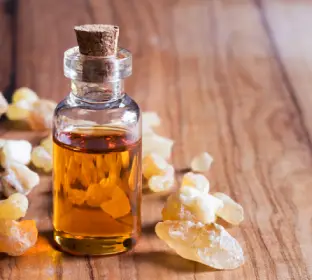Description:
Frankincense, also known as olibanum, is an aromatic resin from Boswellia trees in the Burseraceae family. The name comes from Old French franc encens, meaning high-quality incense. True frankincense is produced by species such as Boswellia sacra, B. frereana, B. serrata, and B. papyrifera. The resin is harvested through tapping, with the best quality collected from the final taps, containing higher levels of aromatic compounds like terpenes, sesquiterpenes, and diterpenes. Most of the world’s frankincense is produced in the Horn of Africa, particularly in regions along the Somalia–Ethiopia border.
The resin contains various chemical compounds such as incensole acetate and phellandrene, and is steam-distilled to produce the essential oil. The oil consists mainly of monoterpenes, sesquiterpenes, and ketones, with components like alpha-pinene and limonene. Unlike solvent-extracted oils, steam-distilled frankincense does not contain significant amounts of boswellic acids. Frankincense essential oil is used in aromatherapy or can be applied to the skin, valued for its calming properties and distinctive fragrance.
USES:
- Aromatherapy: Frankincense essential oil is commonly used to promote relaxation, reduce stress, and improve mood.
- Spiritual Practices: Burned as incense in various religious ceremonies to purify spaces, ward off evil spirits, and cleanse the air. It is often used in rituals, such as exorcisms and blessings.
- Medicinal Uses:
- In Persian Medicine: Used for treating conditions like diabetes, gastritis, and stomach ulcers.
- In Traditional Chinese Medicine (TCM): Applied topically or orally for pain relief, improving blood circulation, treating blood stasis, and conditions like stroke, locked jaw, and menstrual abnormalities.
- Skin Care: Frankincense oil is used in skin care for its anti-inflammatory, healing, and rejuvenating properties. It is often included in creams and ointments for scar healing and anti-aging benefits.
- Religious and Cultural Offerings: In Christianity, frankincense was one of the gifts presented to the Christ Child by the magi. In Jewish traditions, it was burned as part of temple offerings, as outlined in the Book of Exodus.
- Pain Relief: Used for its anti-inflammatory properties to help alleviate joint pain, muscle aches, and headaches.
- Air Freshening: Used in incense form to freshen the air and create a calming, soothing environment in homes or places of worship




